-
 Bitcoin
Bitcoin $105,734.0170
-1.51% -
 Ethereum
Ethereum $2,414.7328
-3.26% -
 Tether USDt
Tether USDt $1.0002
0.00% -
 XRP
XRP $2.1748
-2.62% -
 BNB
BNB $647.5663
-1.72% -
 Solana
Solana $148.1710
-3.81% -
 USDC
USDC $0.9999
-0.01% -
 TRON
TRON $0.2799
-0.02% -
 Dogecoin
Dogecoin $0.1586
-4.17% -
 Cardano
Cardano $0.5440
-5.03% -
 Hyperliquid
Hyperliquid $37.0680
-6.59% -
 Bitcoin Cash
Bitcoin Cash $501.2052
-4.01% -
 Sui
Sui $2.6846
-3.47% -
 Chainlink
Chainlink $12.8488
-3.38% -
 UNUS SED LEO
UNUS SED LEO $8.9480
-1.51% -
 Avalanche
Avalanche $17.2059
-3.87% -
 Stellar
Stellar $0.2270
-4.75% -
 Toncoin
Toncoin $2.7889
-3.93% -
 Shiba Inu
Shiba Inu $0.0...01126
-1.76% -
 Litecoin
Litecoin $83.6893
-3.36% -
 Hedera
Hedera $0.1445
-4.49% -
 Monero
Monero $312.4014
-2.58% -
 Dai
Dai $1.0000
0.00% -
 Ethena USDe
Ethena USDe $1.0001
-0.01% -
 Polkadot
Polkadot $3.2920
-3.32% -
 Bitget Token
Bitget Token $4.4629
-1.81% -
 Uniswap
Uniswap $6.5386
-8.42% -
 Aave
Aave $260.3780
-6.01% -
 Pepe
Pepe $0.0...09308
-4.54% -
 Pi
Pi $0.4864
-3.04%
Does USDT rely on bank custody?
USDT maintains stability by pegging to the USD, with bank custody playing a crucial role in holding reserves, though it introduces risks like bank failures and regulatory scrutiny.
Apr 06, 2025 at 03:00 pm
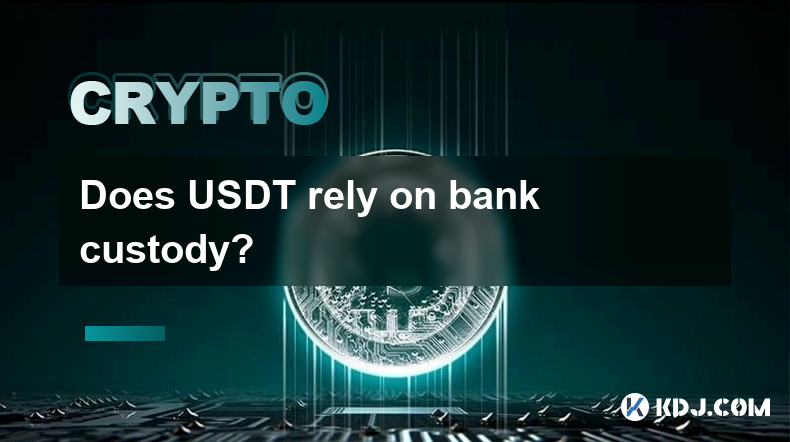
Tether (USDT) is a widely used stablecoin in the cryptocurrency market, designed to maintain a stable value by pegging it to the US dollar. One of the critical aspects of understanding USDT is its reliance on bank custody. This article will delve into the mechanisms behind USDT's operations, specifically focusing on the role of bank custody in its ecosystem.
What is USDT and How Does it Work?
USDT, also known as Tether, is a type of cryptocurrency known as a stablecoin. Stablecoins aim to offer the benefits of digital currencies while maintaining a stable value. USDT achieves this stability by being pegged to the US dollar on a 1:1 basis. For every USDT in circulation, Tether Ltd., the company behind USDT, claims to hold an equivalent amount in US dollars or equivalent assets.
The operation of USDT involves several steps:
- Issuance: When a user wants to buy USDT, they typically send US dollars to Tether Ltd., which then issues an equivalent amount of USDT.
- Redemption: Conversely, when a user wants to convert USDT back to US dollars, they send their USDT to Tether Ltd., which then returns the equivalent amount in US dollars.
- Maintenance: Tether Ltd. ensures that the total value of USDT in circulation matches the total value of their reserves.
The Role of Bank Custody in USDT
Bank custody plays a significant role in the operations of USDT. Tether Ltd. uses banks to hold the US dollars that back the USDT in circulation. This is crucial for maintaining the peg and ensuring that users can redeem their USDT for US dollars at any time.
Tether Ltd. has historically used various banks to hold its reserves. These banks act as custodians, safeguarding the funds that back USDT. The use of bank custody provides a layer of security and trust, as banks are regulated institutions with established protocols for handling large sums of money.
However, the reliance on bank custody also introduces certain risks. If a bank holding Tether's reserves faces financial difficulties or regulatory issues, it could impact Tether's ability to maintain its peg. Additionally, the transparency of Tether's bank relationships has been a point of contention, with some users and regulators calling for more detailed disclosures about which banks are involved and the exact nature of their agreements.
How Tether Manages Its Reserves
Tether Ltd. manages its reserves through a combination of cash and cash equivalents, as well as other assets. According to Tether's attestations, a significant portion of its reserves is held in cash and bank deposits. These cash reserves are typically held in banks, which underscores the importance of bank custody in Tether's operations.
In addition to cash, Tether also holds other assets such as commercial papers, treasury bills, and other securities. These assets are also managed through financial institutions, which again highlights the role of bank custody. The diversification of assets helps Tether to maintain liquidity and stability, but it also means that the company's operations are closely tied to the financial system and the institutions within it.
Transparency and Audits
Transparency has been a significant issue for Tether. The company has faced criticism for not providing regular, comprehensive audits of its reserves. Instead, Tether has opted for attestations, which are less rigorous than full audits. These attestations confirm that Tether holds sufficient reserves to back the USDT in circulation, but they do not provide detailed information about the composition of those reserves or the specific banks involved.
Tether's reliance on bank custody is evident in its attestations, which often mention the use of bank deposits as part of its reserve holdings. However, the lack of detailed information about which banks are involved and the exact nature of their agreements has led to ongoing debates about the true level of transparency and the potential risks associated with Tether's operations.
Risks and Challenges
The reliance on bank custody introduces several risks and challenges for Tether. One of the primary risks is the potential for bank failures or financial instability. If a bank holding Tether's reserves were to face financial difficulties, it could impact Tether's ability to maintain its peg and fulfill redemption requests.
Another challenge is regulatory scrutiny. Banks are subject to various regulations, and any changes in these regulations could affect Tether's ability to use bank custody effectively. Additionally, regulators have expressed concerns about the transparency and stability of stablecoins like USDT, which could lead to increased oversight and potential restrictions on Tether's operations.
Alternatives to Bank Custody
While bank custody is a significant part of Tether's operations, the company has explored alternatives to mitigate risks and enhance stability. One such alternative is the use of decentralized finance (DeFi) platforms. Tether has started to hold some of its reserves in DeFi protocols, which offer a different approach to custody and asset management.
DeFi platforms operate on blockchain networks and are not subject to the same regulatory constraints as traditional banks. By diversifying its reserves across both traditional banks and DeFi platforms, Tether aims to reduce its reliance on any single type of custody and enhance the overall resilience of its operations.
The Future of USDT and Bank Custody
The future of USDT and its reliance on bank custody will likely be shaped by several factors, including regulatory developments, market dynamics, and technological advancements. As the cryptocurrency market continues to evolve, Tether may need to adapt its approach to custody to meet changing demands and mitigate risks.
Regulatory changes could play a significant role in shaping Tether's use of bank custody. Increased scrutiny and potential new regulations could force Tether to modify its relationships with banks or explore alternative custody solutions. Additionally, advancements in blockchain technology and DeFi could provide new opportunities for Tether to diversify its reserves and enhance the stability of USDT.
Common Questions Related to USDT and Bank Custody
Q: What is the primary role of bank custody in USDT's operations?
A: The primary role of bank custody in USDT's operations is to hold the US dollars and other assets that back the USDT in circulation. Banks act as custodians, safeguarding these funds and ensuring that Tether can maintain its peg and fulfill redemption requests.
Q: How does Tether ensure the stability of USDT?
A: Tether ensures the stability of USDT by maintaining a reserve of US dollars and other assets that matches the total value of USDT in circulation. This reserve is held in banks and other financial institutions, which helps to maintain the peg and ensure liquidity.
Q: What are the risks associated with Tether's reliance on bank custody?
A: The risks associated with Tether's reliance on bank custody include potential bank failures, financial instability, and regulatory changes. If a bank holding Tether's reserves faces difficulties, it could impact Tether's ability to maintain its peg and fulfill redemption requests.
Q: How transparent is Tether about its use of bank custody?
A: Tether has faced criticism for its lack of transparency regarding its use of bank custody. While the company provides attestations confirming that it holds sufficient reserves, it does not disclose detailed information about the specific banks involved or the exact nature of their agreements.
Q: What alternatives to bank custody has Tether explored?
A: Tether has explored alternatives to bank custody, including the use of decentralized finance (DeFi) platforms. By holding some of its reserves in DeFi protocols, Tether aims to diversify its custody solutions and enhance the overall resilience of its operations.
Q: How might regulatory changes impact Tether's use of bank custody?
A: Regulatory changes could significantly impact Tether's use of bank custody. Increased scrutiny and potential new regulations could force Tether to modify its relationships with banks or explore alternative custody solutions to comply with new requirements and mitigate risks.
Disclaimer:info@kdj.com
The information provided is not trading advice. kdj.com does not assume any responsibility for any investments made based on the information provided in this article. Cryptocurrencies are highly volatile and it is highly recommended that you invest with caution after thorough research!
If you believe that the content used on this website infringes your copyright, please contact us immediately (info@kdj.com) and we will delete it promptly.
- Bitcoin Price Rollercoaster, ICO Mania, and the Fear of Missing Out (FOMO)
- 2025-07-02 13:10:12
- Coinbase, Crypto, and Amazon: A New Era of Financial Integration
- 2025-07-02 12:30:12
- BlackRock, Crypto.com, and Tokenization: A New Era for TradFi and DeFi
- 2025-07-02 13:10:12
- Meme Coins in 2025: Viral Power and Investment Potential
- 2025-07-02 13:30:12
- Binance, Airdrops, and Market Share: A 2025 Crypto Powerhouse
- 2025-07-02 12:30:12
- Tom Lee, MicroStrategy, and Ethereum: Bullish Signals and Strategic Plays
- 2025-07-02 13:30:12
Related knowledge
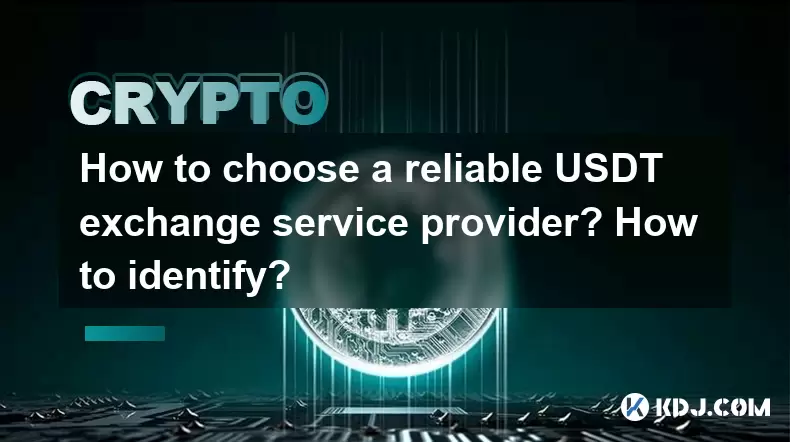
How to choose a reliable USDT exchange service provider? How to identify?
Jun 12,2025 at 03:15pm
Understanding the Role of USDT in Cryptocurrency TradingUSDT (Tether) is one of the most widely used stablecoins in the cryptocurrency market. It is designed to maintain a 1:1 peg with the U.S. dollar, offering traders and investors a way to hedge against volatility while remaining within the crypto ecosystem. Choosing a reliable USDT exchange service p...
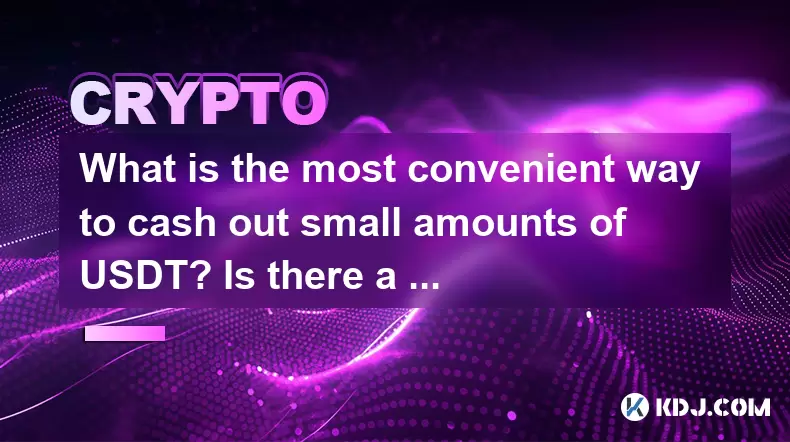
What is the most convenient way to cash out small amounts of USDT? Is there a shortcut?
Jun 11,2025 at 11:00pm
Understanding the Need to Cash Out Small USDT AmountsCashing out small amounts of USDT can be a challenge for many crypto users. Traditional methods often involve high fees, minimum withdrawal limits, or cumbersome verification processes that make it inefficient for small transactions. The key is to find a method that balances speed, cost, and convenien...
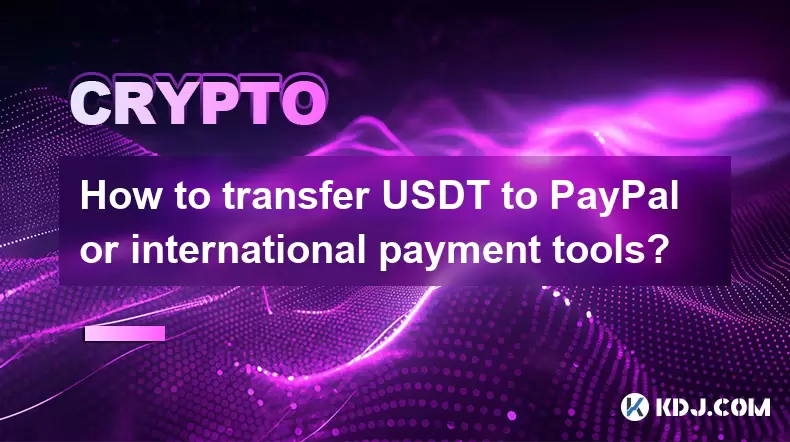
How to transfer USDT to PayPal or international payment tools?
Jun 15,2025 at 05:28am
Understanding the Basics of USDT and PayPal IntegrationUSDT (Tether) is a stablecoin pegged to the US dollar, offering blockchain-based value transfer with minimal volatility. PayPal, on the other hand, is a centralized digital wallet that facilitates fiat currency transactions globally. Direct integration between USDT and PayPal does not exist due to t...
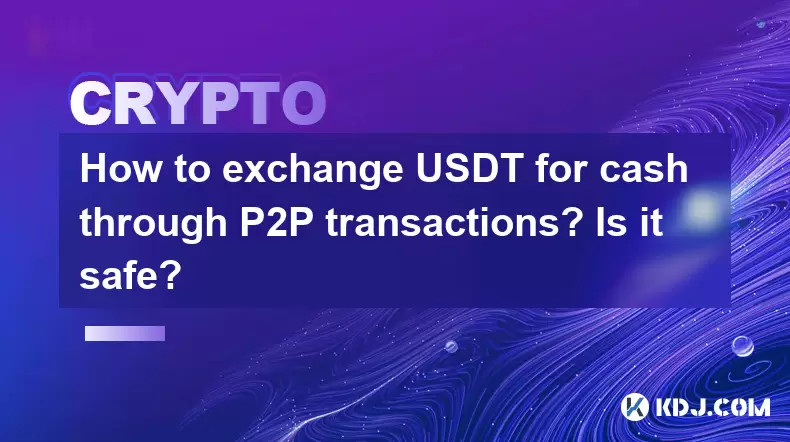
How to exchange USDT for cash through P2P transactions? Is it safe?
Jun 18,2025 at 07:56am
Understanding USDT and P2P TransactionsTether (USDT) is a stablecoin pegged to the value of the US dollar, making it a popular choice for users who want to avoid the volatility of other cryptocurrencies while still participating in the crypto ecosystem. Peer-to-peer (P2P) transactions allow individuals to trade directly with each other without going thr...
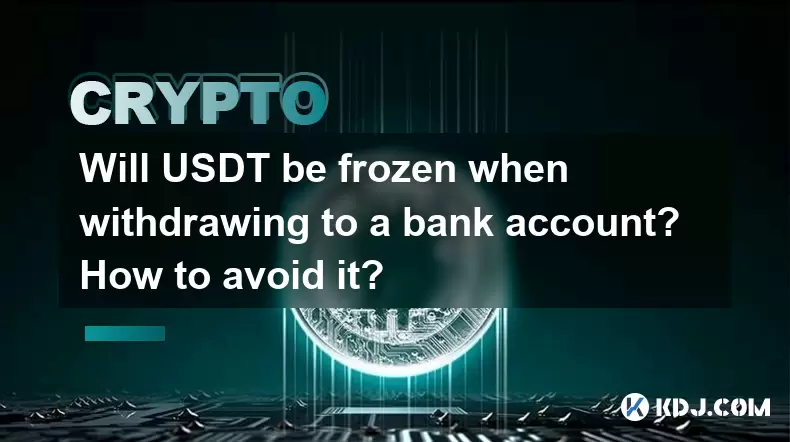
Will USDT be frozen when withdrawing to a bank account? How to avoid it?
Jun 15,2025 at 10:03am
Understanding USDT Withdrawals and Bank Account Freezing RisksWhen users decide to withdraw USDT (Tether) to a bank account, one of the most common concerns is whether their funds will be frozen during the process. This concern stems from real-life cases where individuals have encountered delays or restrictions when converting digital assets into fiat c...

How to avoid risks when exchanging USDT for cash? What are the pitfalls?
Jun 11,2025 at 08:14pm
Understanding the Risks of Exchanging USDT for CashWhen exchanging USDT (Tether) for cash, users must be aware of the potential risks involved. As a stablecoin pegged to the US dollar, USDT is widely used in crypto transactions due to its price stability. However, converting it into fiat currency like USD or CNY can expose users to several pitfalls, inc...

How to choose a reliable USDT exchange service provider? How to identify?
Jun 12,2025 at 03:15pm
Understanding the Role of USDT in Cryptocurrency TradingUSDT (Tether) is one of the most widely used stablecoins in the cryptocurrency market. It is designed to maintain a 1:1 peg with the U.S. dollar, offering traders and investors a way to hedge against volatility while remaining within the crypto ecosystem. Choosing a reliable USDT exchange service p...

What is the most convenient way to cash out small amounts of USDT? Is there a shortcut?
Jun 11,2025 at 11:00pm
Understanding the Need to Cash Out Small USDT AmountsCashing out small amounts of USDT can be a challenge for many crypto users. Traditional methods often involve high fees, minimum withdrawal limits, or cumbersome verification processes that make it inefficient for small transactions. The key is to find a method that balances speed, cost, and convenien...

How to transfer USDT to PayPal or international payment tools?
Jun 15,2025 at 05:28am
Understanding the Basics of USDT and PayPal IntegrationUSDT (Tether) is a stablecoin pegged to the US dollar, offering blockchain-based value transfer with minimal volatility. PayPal, on the other hand, is a centralized digital wallet that facilitates fiat currency transactions globally. Direct integration between USDT and PayPal does not exist due to t...

How to exchange USDT for cash through P2P transactions? Is it safe?
Jun 18,2025 at 07:56am
Understanding USDT and P2P TransactionsTether (USDT) is a stablecoin pegged to the value of the US dollar, making it a popular choice for users who want to avoid the volatility of other cryptocurrencies while still participating in the crypto ecosystem. Peer-to-peer (P2P) transactions allow individuals to trade directly with each other without going thr...

Will USDT be frozen when withdrawing to a bank account? How to avoid it?
Jun 15,2025 at 10:03am
Understanding USDT Withdrawals and Bank Account Freezing RisksWhen users decide to withdraw USDT (Tether) to a bank account, one of the most common concerns is whether their funds will be frozen during the process. This concern stems from real-life cases where individuals have encountered delays or restrictions when converting digital assets into fiat c...

How to avoid risks when exchanging USDT for cash? What are the pitfalls?
Jun 11,2025 at 08:14pm
Understanding the Risks of Exchanging USDT for CashWhen exchanging USDT (Tether) for cash, users must be aware of the potential risks involved. As a stablecoin pegged to the US dollar, USDT is widely used in crypto transactions due to its price stability. However, converting it into fiat currency like USD or CNY can expose users to several pitfalls, inc...
See all articles

























































































